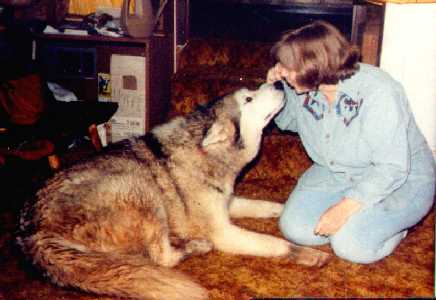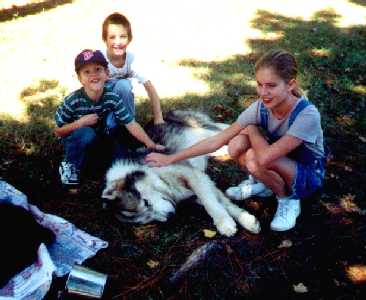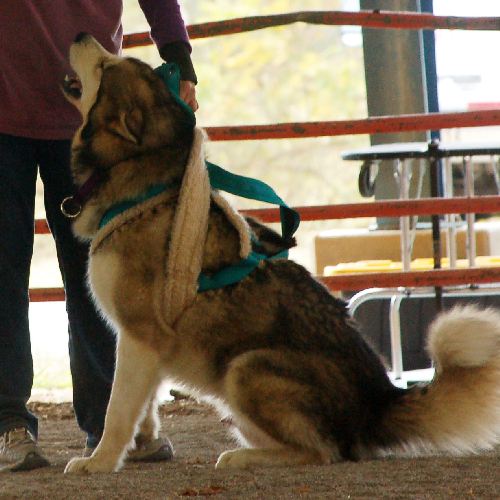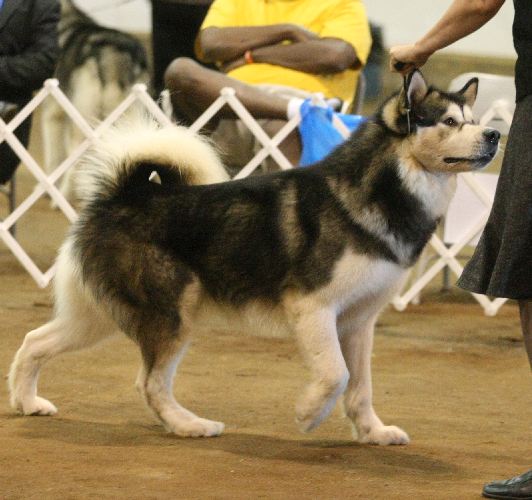
There is a natural size range in Alaskan Malamutes, says so right there in our Standard, but that Standard also says that the ideal Malamute should be 75lbs (female) to 85lbs (males). Hundreds, if not thousands, of generations have resulted in that size range as the ideal for Malamutes. Perfection. There are breeds that should be 150-200lbs, and if that’s what you want, you should get one. A well-bred Saint Bernard, Newfoundland, or Mastiff should satisfy your yearnings for a super-sized dog because they are SUPPOSED to be that large.
But I want a “giant” Mal. And there are oh, so many breeders out there who will provide a “giant” Mal for you. But beware of the trap.
What makes a Mal a giant? The breeder says so. Really, all someone has to do is SAY they have giant lines and SAY they are producing giants. There is no certification or spot check to decide someone is breeding the size they claim to breed.
Are giants M’Loots? No, there are no pure M’Loots anymore. Breeders who advertise M’Loot Malamutes are preying on your ignorance. ALL of today’s Malamutes, except a very few pure Kotzebues, are a blend of about 50/50 Kotzebue/M’Loot genes. No one is breeding pure M’loot lines because they don’t exist.

Aren’t giants the original, true Malamute? Not even remotely true. The original, true Alaskan Malamute were village dogs, and they had a natural size range. But ask yourselves a hard question: do you really believe that sustainance peoples like the Inuit who were barely surviving could afford to feed a whole team of 200# dogs? Do you know how much they eat compared to how much they pull? If you believe that, then look to the larger sled breeds like CEDs and Greenland dogs (who aren’t that big either), but don’t expect a Malamute to be that large.
The first registered Malamutes were the Kotzebue, and they ranged in size from 50-85#, says so right in the original 1935 Standard. After a disaster in the Antarctic, the studbooks were reopened to allow more dogs into the AKC registry to maintain the breed. This was a compromise between allowing non-Kotzebue into the AKC stud books and extinction. This second wave of dogs were the M’Loot and the third or Hinman strain. These second wave dogs were larger, yes, and they brought in more bone, bigger coats, red coats, ChD/dwarfism, long-coats, and harsher temperaments. The compromise standard called for a 75# girl and an 85# boy. No where near giants, even then. That new standard spells out that there is a natural variation in size in the Malamute, but preference should be given to the one closest to the standard of 75 & 85#. The majority of kennels back in the day blended the Kotzebue & M’loot lines with a trace of Hinman and we’ve continued that blending until today.

His parents were both 75#
How big are the giants? That’s an interesting question. Giant breeders are advertising wizards. They frequently claim weights of up to 200lbs and more with nary a blush. Yet none of these huge dogs ever manage to get on a vets scale AND have a vets assertion that they aren’t morbidly obese. The highest weight ever recorded for a Malamute in the IWPA is 180#, on a dog that the previous year weighed 140#. Maybe he was ill the first year, or maybe the second year’s weight was 40# of fat. As a rescuer, I have seen many many dogs from so-called giant kennels, female Sakira was 54lbs, female Kentai was 80lbs. Female Mariah was advertised as 140lbs, and she did weigh that much, but 1 year after she arrived, her healthy weight here was 85#, hardly a giant. Male Icebear was 104lbs. Most “giant” stud dogs I have ever met, and they are considerable, was in the 90-110lb range, advertised sometimes 100lbs heavier than that online.
Now, Wayeh started with a Wakon bitch named Misty who was 150#. Which is nowhere near lean working weight. And we’ve been breeding 12 generations to keep her good qualities and put them on a longer-lived, healthier, standard-sized frame.
But if the breeder says the dog is 200lbs on the website, isn’t it 200lbs? Some giant breeders put notations on their dog’s pages of advertising weight and real weight. They admit lying. Once the admission of a lie is there, how can you trust even the so-called ‘real’ weight?

(Did you guess 90#?)
How do they get their dogs to those big weights? Well, if you want to put weight on a Malamute, free feed them. Give a Mal an opportunity to eat all day, every day and guess what, they DO. These dogs are NOT at a healthy weight and are not in good physical shape. No serious competitor EVER free feeds their dogs, because they can’t have obese dogs waddling around the ring or pulling in harness.
What size can I expect from a giant puppy? 100 LEAN lbs is a big girl, 110 LEAN lbs is a big boy, many are nowhere near those weights. And, something to consider is that show kennels produce those weights as well, and bigger. Many giants are significantly SMALLER than that as well.
There is a natural range in size in every litter. I’ve had parents who were both a 75# lean working weight produce a litter that included Wyatt who was 118# — very lean working weight. And bred to a standard 75# bitch, he produced a 3-puppy litter. The puppy I kept is 85#, his siblings are reportedly 130 & 140#. They have never worked a day in their lives and the owner is happy with how big they are. Is that the weight they would be if they lived here?
Not only no, but heck, no.
What are the main difference between giant kennels and standard kennels?
1) Health warranties. Giant breeders usually give a 12-month health warranty and usually only against severe hip displasia. Malamutes are not fully grown until they are 4yo. Many diseases don’t show up until after 12 months. A 12-month health warranty is a travesty and should tell you right away that you are dealing with someone who CAN’T warranty their dogs.
2) Experience. You know how to get 3 generations on your premises? Buy a dog, breed him, breed his son when he’s a year old — presto chango “YOU” have three generations in 1 year. Experience is not 3 generations, but decades of breeding healthy dogs and producing the same.
3) Requirements of their puppy buyers. There won’t be many because once the check clears, they don’t want to hear from you. They will SAY they require spay/neuter, but they won’t follow up the contract that probably didn’t get you to sign anyway. In order to know if you are breeding a healthy generation, you must know what was produced in the previous generation. Saying that people will call you with problems is not the same as FINDING OUT. Puppy buyers should be reporting back with hips, eyes, and thyroid test results at 2years. If the breeder doesn’t require this, how can they know what they are producing in the next generation?
3) Hidden pedigrees. I see this over and over again. How hard could it be to put a pedigree on the web. ‘Pedigrees available upon request’ means they don’t want you to know what their pedigrees are. Why would that be? What are they hiding?
4) Champion lines. This means there is 1 champion in 20 generations, not that THEY show their dogs.
5) Health clearances listed for grandparents, not parents. This is a classic. YOU MUST CHECK EVERY GENERATION. To rely on the work of the former generation is lazy and neglectful.
6) Extravagant price for a puppy you could get in almost any backyard. Check what other breeders are selling their puppies for. A higher price should mean a higher standard. Not a marketing gimmick.
- The parents should have health clearances CLEARLY displayed;
- The pedigree should be CLEARLY displayed;
- Parents should be PROVEN in harness, the show ring, or obedience;
- The health warranty should reflect the higher price; and
- Support should be real and active.
7) Doing something with their dogs besides just breeding them. So you just want pet. You want a healthy one that looks like a Malamute don’t you? Buying a show champion or working champion and advertising champion-sired does not mean the breeder is doing anything but buying with an eye towards advertising. Ask how many of their dogs are DOING something besides breeding? One, two? If they own 10 dogs, it seems a little strange that only one of them is actually getting outside the kennel yard and DOING something. If they own 30 dogs, you’d hope to see some sort of indication that they didn’t LIVE in those kennels 24/7, do they get to go somewhere besides for a photo opportunity several years ago?
8) Their dogs are AKC or UKC registered. There are 30+ registries in the US, and the vast majority of those are fly-by-night bogus registries whose sole purpose is to provide “registration papers” to satisfy a gullible public. Anyone with a desktop printer can give you papers, but do they mean anything? Do these registries have kennel inspections, a DNA program, dog shows, and 100 years of stud books?
9) Breeding for size. Sounds a little confusing, but breeding for size means you put that first. So you can have a stud dog who produces hip displasia, or has littermates who are hip displastic, but you ignore that because he also produces size. Or a dog who is big himself, but he has a crippled foot, so you breed him anyway. You can have a brood bitch who produces evil temperaments, but they are pretty, so you keep breeding her. When you breed for one thing, over the entire rest of the Standard, than you’re setting yourself up to make compromises. That hurts the puppies and their owners.
A good breeder is a good breeder is a good breeder, no matter the size of their dogs.
But the wise puppy buyer will recognize hype when they hear it. The standard is what makes a Malamute a Malamute, it’s our blue print, not something to be sneered at. No one should fabricate lies about the history of our wonderful breed or the actual size of their dogs. A good breeder cares:
- That they are breeding Malamutes who look like Malamutes, and not over-grown Saint Bernards.
- About the mental and physical welfare of their brood bitches and stud dogs and gives them things to do besides eat and breed.
- Who they sell to and require applications, contracts, and follow-up. And,
- For the future health and welfare of their puppies.
A good breeder produces puppies they are proud of, for the life of the puppy, no matter how much they weigh.